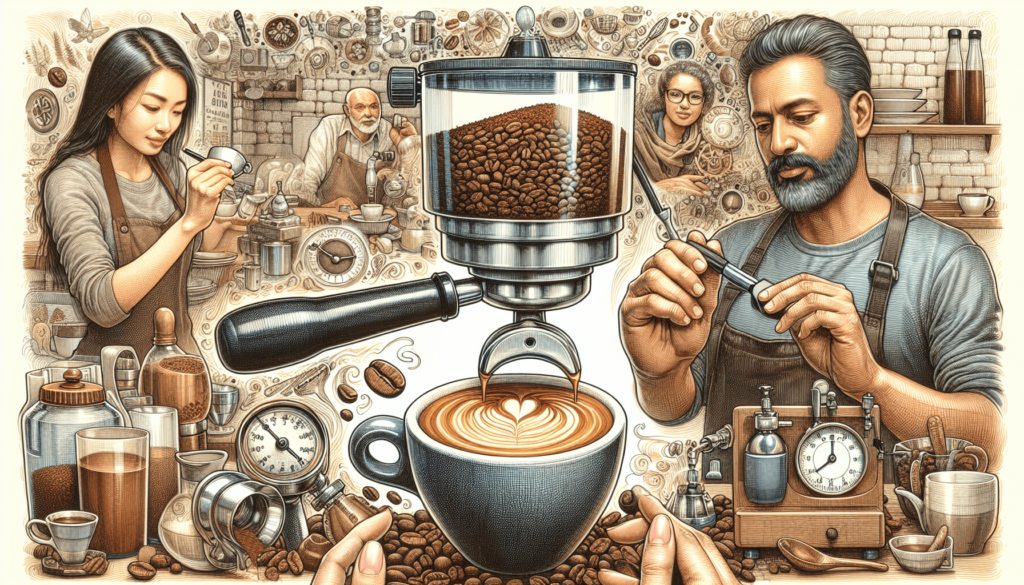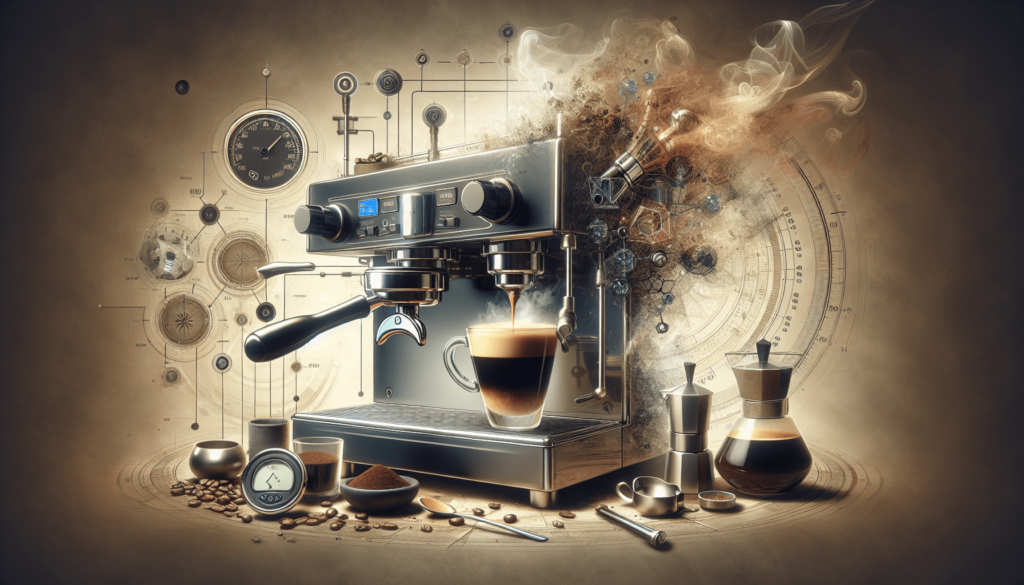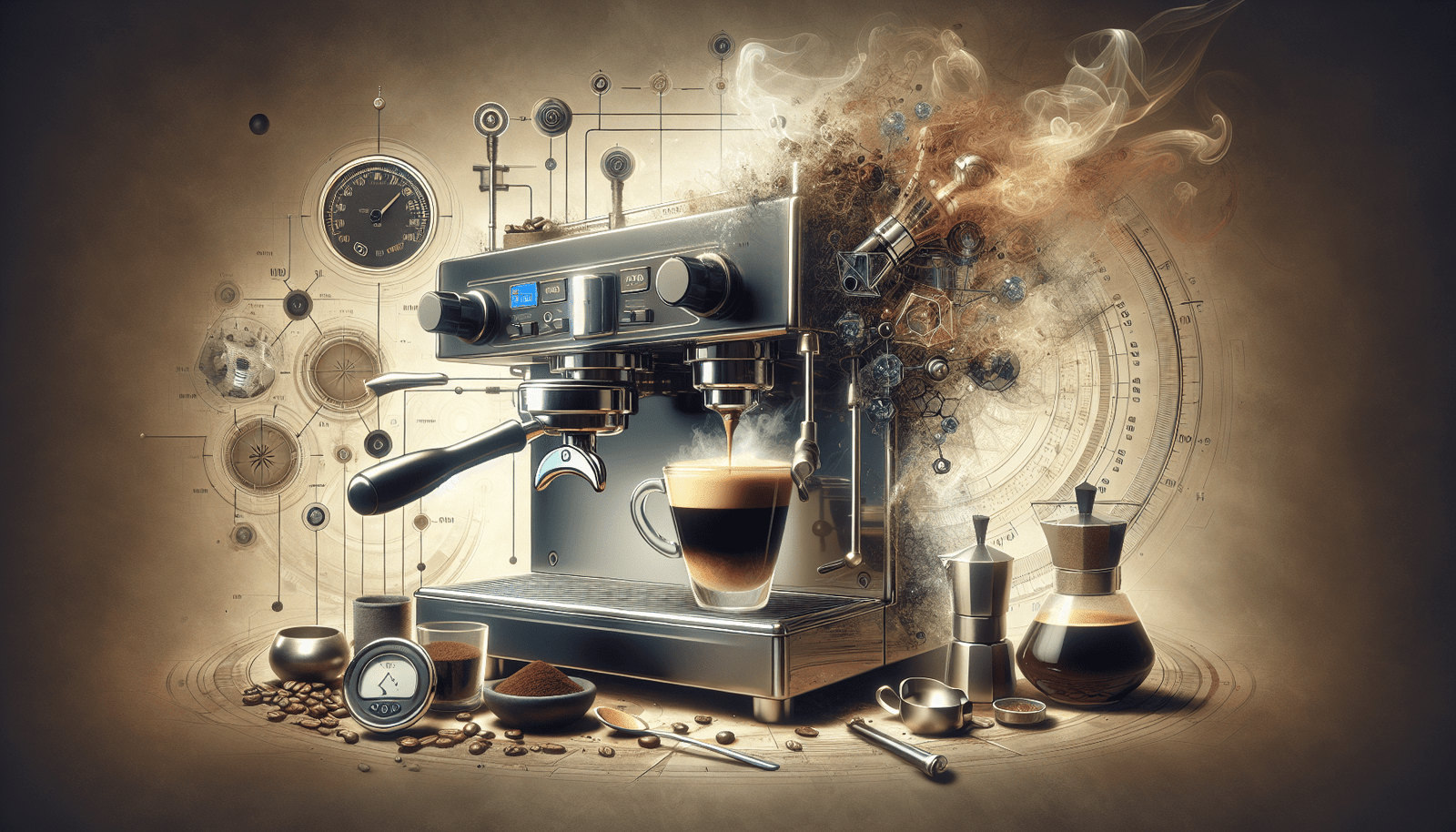Are you a coffee enthusiast who appreciates the delicate balance of flavors in each cup? If so, then you understand the importance of a perfectly crafted espresso shot. In this article, we will explore the art of perfecting the espresso shot, delving into the meticulous techniques and expert knowledge required to achieve that rich, aromatic elixir. From the precise grind size to the ideal extraction time, we will uncover the secrets behind creating a flawless espresso shot that will tantalize your taste buds and leave you craving for more. So grab your favorite mug and get ready to embark on a journey into the world of coffee perfection.

Understanding the Basics
What is an espresso shot?
An espresso shot is a concentrated form of coffee that is made by forcing hot water through finely ground coffee beans. It is the foundation of various espresso-based beverages such as lattes, cappuccinos, and Americanos. The key characteristic of an espresso shot is its rich and bold flavor, which is achieved through the precise extraction process.
What makes a perfect espresso shot?
A perfect espresso shot is a balance of various factors such as extraction time, dose, temperature, and grind size. It should have a rich crema, which is the reddish-brown foam that forms on top of the shot. The taste profile of a perfect espresso shot is complex, with notes of sweetness, acidity, and bitterness harmoniously blended together.
Essential ingredients for an espresso shot
To create a perfect espresso shot, you need three essential ingredients: coffee beans, water, and pressure. Coffee beans should be freshly roasted and ground just before extraction to preserve their flavors. The water used should be filtered and heated to the optimal temperature, usually between 195°F and 205°F (90°C to 96°C). Finally, the pressure generated by an espresso machine is crucial for extracting the flavors from the coffee grounds.
Selecting the Right Coffee Beans
Choosing the right coffee bean variety
When selecting coffee beans for an espresso shot, it is important to choose a variety that is specifically suited for espresso brewing. Espresso beans are typically roasted longer than beans meant for other brewing methods, which gives them a darker and oilier appearance. Look for beans with tasting notes that align with your flavor preferences, whether it be chocolate, fruit, or nutty undertones.
The importance of freshness
Freshness is key when it comes to coffee beans for an espresso shot. As coffee beans age, they lose their aroma and flavor. It is best to purchase whole beans and grind them just before use to ensure maximum freshness. Look for beans with a roast date, and aim to consume them within two to three weeks after that date for optimal flavor.
Roast level and its impact on flavor profile
The roast level of coffee beans has a significant impact on the flavor profile of an espresso shot. Lighter roasts tend to have more acidity and bright flavors, while darker roasts develop more body and intensity. Finding the right roast level for your taste preferences is crucial in creating the perfect espresso shot. Experiment with different roast profiles to discover the flavors that you enjoy the most.
Proper Grinding Techniques
Why grinding is crucial for espresso
Grinding coffee beans is a crucial step in the espresso-making process because it determines the surface area of the coffee particles that will be exposed to water during extraction. Finely ground coffee allows for a slower extraction, resulting in a rich and intense flavor. A consistent grind size is essential to ensure even extraction and avoid any over- or under-extraction.
Different types of coffee grinders
There are two main types of coffee grinders: blade grinders and burr grinders. Blade grinders are more affordable but tend to produce an inconsistent grind size. Burr grinders, on the other hand, offer a more precise and consistent grind. Investing in a quality burr grinder will greatly enhance your ability to achieve the perfect espresso shot.
Finding the appropriate grind size
The grind size for espresso should be fine and powdery, similar to table salt. However, the exact grind size may need to be adjusted based on the equipment and the specific characteristics of the coffee being used. It is recommended to start with a medium-fine grind and make small adjustments until the desired extraction time and taste are achieved.
Ensuring consistency in grind
Consistency in grind size is essential for a consistent espresso shot. Inconsistent grind sizes can lead to uneven extraction and ultimately affect the taste and quality of the shot. Regularly calibrating and cleaning your grinder, as well as using a scale to measure the dose, can help ensure a consistent grind size and improve the overall quality of your espresso shot.
Mastering the Espresso Machine
Understanding the different components
To master the espresso machine, it is important to understand its different components. These include the portafilter, group head, boiler, and steam wand. The portafilter is where the coffee grounds are placed, and it is attached to the group head, which releases hot water into the portafilter for extraction. The boiler is responsible for heating water to the desired temperature, and the steam wand is used for steaming and frothing milk.
Calibrating and adjusting the machine
Calibrating and adjusting the espresso machine is crucial to ensure optimal extraction. This involves adjusting the grind size, temperature, and extraction time. Each machine is unique, so it is important to refer to the manufacturer’s instructions and make adjustments based on the desired flavor profile. Regularly monitoring and fine-tuning the machine will help you consistently achieve the perfect espresso shot.
Managing water temperature and pressure
Water temperature and pressure are vital factors in the espresso extraction process. The water temperature should be within the range of 195°F to 205°F (90°C to 96°C) to ensure proper extraction of flavors without scorching the coffee grounds. The pressure should be maintained at approximately 9 bars for optimal extraction. Monitoring and adjusting these factors will help you achieve a balanced and flavorful espresso shot.
Ensuring cleanliness and maintenance
To maintain the quality of your espresso shots, it is important to keep the espresso machine clean and well-maintained. Regularly cleaning the group head, portafilter, and steam wand will prevent any build-up of coffee residue or milk proteins that can negatively impact the taste of the shot. Additionally, descaling the machine periodically will help remove mineral deposits and ensure consistent performance.

Optimizing the Espresso Shot
Understanding the 4 M’s: Measurement, Machines, Methods, and Maintenance
The 4 M’s are essential elements to consider when optimizing the espresso shot. Measurement refers to accurately weighing the coffee dose and yield ratios to maintain consistency. Machines include the espresso machine, grinder, and any additional equipment used for extraction. Methods refer to the specific techniques employed during brewing. Maintenance involves regular cleaning, calibration, and maintenance of the equipment to ensure optimal performance.
Dose and yield ratios
Dose and yield ratios play a crucial role in achieving the perfect espresso shot. The dose refers to the amount of coffee used, typically measured in grams. A standard dose for a double shot ranges from 18 to 20 grams of coffee. The yield is the amount of liquid espresso extracted, typically measured in milliliters. A common yield ratio is 1:2, meaning that for every gram of coffee, two grams of liquid espresso are extracted.
The importance of pre-infusion
Pre-infusion is a step in the espresso extraction process that involves saturating the coffee grounds with a small amount of water before applying full pressure. This allows for a more even extraction and contributes to a richer and more balanced flavor profile. Pre-infusion can be achieved using a machine with a programmable pre-infusion feature or by manually controlling the flow of water during the initial phase of extraction.
Achieving the perfect extraction time
The extraction time refers to the duration it takes for the espresso shot to be extracted from the coffee grounds. The ideal extraction time for a double shot is typically between 25 and 30 seconds. This time frame allows for the extraction of the desired flavors without over-extraction, which can result in a bitter taste. Experimenting with different extraction times and adjusting other variables can help you achieve the perfect balance.
Perfecting the Espresso Grind
Identifying under-extraction and over-extraction
Under-extraction occurs when the coffee grounds are not fully extracted, resulting in a weak and sour-tasting espresso shot. Over-extraction, on the other hand, happens when the coffee grounds are excessively extracted, resulting in a bitter and unpleasant taste. By tasting the shot and observing the flow, color, and flavor, you can identify whether it is under-extracted or over-extracted and make necessary adjustments.
Adjusting grind size to optimize extraction
Adjusting the grind size allows you to optimize the extraction process. If the shot tastes sour and weak, the grind is likely too coarse, and the extraction time is too short. In this case, grinding the coffee finer will increase the surface area, allowing for more extraction. If the shot tastes bitter and over-extracted, the grind is likely too fine, and the extraction time is too long. Grinding coarser will decrease the extraction and reduce bitterness.
Tasting and adjusting for balanced flavors
Tasting the espresso shot is essential for identifying the flavors and making adjustments. Take note of the sweetness, acidity, and bitterness in the shot. Adjusting variables such as grind size, extraction time, and even the coffee bean variety can help achieve a more balanced flavor profile. By consistently tasting and adjusting, you can refine your technique and create a consistently delicious espresso shot.
Mastering Milk Steaming and Texturing
Selecting the right milk
Selecting the right milk is crucial for achieving the perfect texture and taste in espresso-based beverages. Whole milk is commonly used for its creamy and rich texture, but alternative milk options such as almond milk or oat milk can also be used for different flavor profiles. It is important to choose a milk that complements the flavors of the coffee and provides the desired level of sweetness and creaminess.
Proper techniques for steaming and frothing
Steaming and frothing milk is an art in itself and requires proper technique. Start by purging any excess water from the steam wand before placing it into the milk pitcher. Position the wand at an angle just below the surface of the milk and slowly introduce steam. As the volume increases, lower the pitcher to maintain the desired texture. Proper technique and practice will result in velvety microfoam with small, uniform bubbles.
Achieving ideal milk temperature and texture
The ideal temperature for steamed milk is typically between 140°F and 160°F (60°C to 71°C). It is important to avoid overheating the milk, as it can scorch and develop a burnt taste. The texture of the milk should be smooth, glossy, and free of large bubbles. Achieving the perfect balance of temperature and texture will enhance the overall experience of the espresso-based beverage.
Creating latte art
Latte art is the finishing touch to a beautifully crafted espresso-based beverage. It involves pouring steamed milk into the espresso shot in a controlled manner to create intricate designs on the surface. With practice and patience, you can master techniques such as the heart, tulip, and rosetta. Latte art not only enhances the visual appeal of the drink but also adds a personal touch and demonstrates the level of skill in the barista’s craft.
The Importance of Timing
Controlling shot timing
Controlling the timing of the espresso shot is crucial for achieving consistent results. This includes the time it takes for the first drops of espresso to appear, the total extraction time, and the time between shots. Each of these factors contributes to the overall quality and taste of the shot. Consistently timing and monitoring these variables allows you to make adjustments and refine your technique.
Recognizing the impact of shot length
The length of the espresso shot refers to the total volume of liquid extracted. It can vary depending on the desired taste profile and the size of the cup. Short shots, also known as ristretto, are typically thicker and more intense in flavor. Long shots, or lungo, have a higher water-to-coffee ratio and are milder in taste. Understanding the impact of shot length on the flavor profile allows you to cater to different preferences.
Understanding the concept of brew ratios
Brew ratios refer to the ratio of coffee dose to liquid yield in an espresso shot. The most common brew ratio is 1:2, which means using twice the amount of liquid yield compared to the dose. However, experimenting with different brew ratios can lead to unique flavor profiles. A higher brew ratio can result in a lighter and more delicate taste, while a lower ratio produces a stronger and more concentrated flavor.
Experimenting and refining timing
Timing plays a critical role in the espresso-making process, and experimentation is key to finding the perfect balance. By adjusting the extraction time, shot length, and brew ratios, you can explore different flavor profiles and discover your preference. Keeping detailed records and tasting notes will help you refine your technique over time and consistently achieve the desired taste in your espresso shots.
Sensory Evaluation
Understanding the taste profile of espresso
Understanding the taste profile of espresso is essential for sensory evaluation. Espresso should have a balanced combination of sweetness, acidity, and bitterness. Sweetness can manifest as caramel, chocolate, or fruity notes. Acidity contributes to the brightness and liveliness of the shot. Bitterness, when well-balanced, adds complexity and depth to the flavor. Developing a discerning palate allows you to appreciate and identify these flavors.
Developing sensory skills
Developing sensory skills is a continuous process that involves training your taste buds and sense of smell. Regularly tasting different coffees, smelling various aromas, and consciously noting the flavors experienced will help refine your sensory skills. Engaging in coffee cupping sessions, attending sensory education classes, and seeking feedback from experienced baristas are all effective methods for honing your ability to evaluate espresso.
Identifying flavor defects and inconsistencies
Sensory evaluation also involves recognizing flavor defects and inconsistencies in the espresso shot. Common defects include sourness, bitterness, astringency, or off-flavors such as rubbery or burnt tastes. By identifying these defects, you can trace them back to specific variables in the brewing process and make necessary adjustments. Consistent evaluation and analysis of the shot’s taste will ultimately lead to higher-quality espresso.
Training your palate
Training your palate involves exposing your taste buds to a wide range of flavors and practicing sensory evaluation. Expand your palate by trying different coffee varietals, origin regions, and roast profiles. Pay attention to the nuances in taste, acidity, and sweetness. Practice tasting and describing the flavors, acidity levels, and mouthfeel. Over time, your palate will become more refined, and you will develop a deeper appreciation for the art of espresso.
Achieving Consistency
Creating a reproducible process
Consistency is the key to achieving the perfect espresso shot every time. Create a reproducible process by documenting and following a standardized workflow. This includes measurements, temperature, grind size, and extraction time. By consistently replicating the same steps, you can minimize variables and ensure a consistent flavor profile in your espresso shots.
Keeping a detailed log of variables
Keeping a detailed log of variables is crucial for understanding and improving your espresso-making process. Record the specific details of each shot, including coffee bean variety, roast level, dose, yield, extraction time, and any adjustments made. This log will serve as a reference point for future improvements and allow you to track trends and patterns in the taste and quality of your shots.
Regularly calibrating and adjusting
Regular calibration and adjustment of your equipment are necessary to maintain the quality and consistency of your espresso shots. This includes calibrating the grinder, testing the water temperature and pressure, and ensuring that all components of the machine are in optimal condition. Regular maintenance and fine-tuning will help prevent performance issues and keep your espresso machine in top shape.
Continuous practice and refinement
Achieving perfection in the espresso-making process requires continuous practice and refinement. Keep experimenting with different variables such as coffee beans, brew ratios, extraction times, and milk steaming techniques. Continuously seeking feedback, attending workshops, and learning from experienced professionals will enable you to refine your skills and achieve greater consistency in producing exceptional espresso shots.
In conclusion, perfecting the art of the espresso shot involves understanding the fundamental elements of espresso extraction, selecting the right ingredients, mastering the equipment, optimizing variables, and continuously refining your skills. By following these guidelines and embracing the ongoing journey of experimentation and practice, you can achieve consistent, balanced, and delicious espresso shots. Cheers to the art of espresso perfection!

